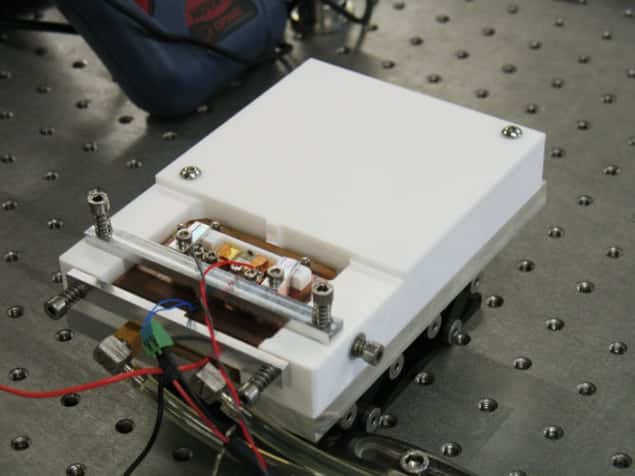
Satellite technology intended for Earth observation has been adapted to create an instrument that can recognize explosives remotely. Developed by a team of scientists in the UK, the system uses an infrared laser to detect volatile compounds given off by explosives and other dangerous materials.
Home-made chemical and explosive weapons pose a significant risk to people in many places around the world. Most improvised devices have some kind of volatile material associated with them. These are often remnants of the ingredients used to make the devices or chemicals that are produced as explosive materials decompose over time. These compounds can be detected if a sensor is placed close enough to sample the surrounding air – but this is a risky business. Remote sensing is a safer option but is not perfect either.
Space-based remote-sensing techniques rely on the fact that every species of molecule has a characteristic radiation absorption spectrum. By measuring this unique pattern of frequencies, the presence – and often the concentration – of a molecular species in a gas can be determined. “Passive” remote sensors simply collect thermal radiation from the scene. However, these are far too insensitive to reveal trace gases at parts per million (ppm) concentrations over the very short absorption distances necessary for detecting explosives. LiDAR, in contrast, is an “active” system that sends out a laser beam and interprets the backscatter. It offers a big jump in sensitivity but each instrument works at only one wavelength. While this is fine for spotting specific gases, it is not suitable for multi-gas detection and the comprehensive investigation of explosives of unknown composition.
Terrestrial application
This new explosives detector was created by Damien Weidmann and his team at Rutherford Appleton Laboratory (RAL). The researchers were originally designing a new passive satellite spectrometer when they realized it could be adapted for use in an active system for detecting trace gases on Earth. Dubbed the Active Coherent Laser Spectrometer (ACLaS), the system uses quantum cascade lasers that are integrated on tiny semiconductor chips and work at room temperature. Crucially, the laser frequency can be tuned and scanned. To tackle the problem of low sensitivity, the illuminating laser beam is in the mid-infrared, which is the atmosphere’s “transparency window” where water-vapour interference is minimal. A further benefit is that the light will not harm human eyes.
The new device has been tested at distances up to 50 m and gives unambiguous chemical identification and quantification readings in as little as 3 s. But it rewards those with a little more patience: “The sensitivity scales with the time you wait to get your reading,” explains Weidmann. “If you wait for 100 s rather than one, you improve the sensitivity by a factor of 10.”
Putting a specific value on the instrument’s sensitivity is difficult because it is more responsive to some molecules than others. However, the researchers say it is in the parts-per-million region. This is sufficient for detecting high-volatility materials and Weidmann’s team is working hard on extending its reach.
“We have an obvious way of doing this,” he says. “We can multiply the power of the laser by 10 very easily, and we’d gain immediately one order of magnitude.” At the same time, the researchers are working on a system to improve the signal-to-noise ratio and predict that they will be able to win another order of magnitude there too.
Multipurpose hazard detector
The researchers believe that the flexibility and range of the ACLaS makes it ideal for all kinds of hazardous or undercover gaseous-phase sampling, including detecting toxic leaks, chemical-warfare agents, illegal drugs manufacture or highly localized industrial air pollution. “[It] has a very high spatial resolution because you’re looking from a distance at a very narrow area and you can direct where you’re looking,” explains Weidmann. “It should really be seen as a generic system that will be able to detect any kind of volatile gas, providing the molecule you’re targeting is specifically absorbing enough.”
The RAL team is working with the UK’s Ministry of Defence and has already begun discussing a licensing agreement with a company that is keen to begin manufacture. Meanwhile, Weidmann and his team are back in the lab pursuing a trio of improvements to the design. In addition to boosting the sensitivity, the researchers plan to improve the device’s “frequency agility”, which means incorporating a more complex laser system to improve the device’s range and therefore the number of species that it can pick out. Finally, they have a long-term aim of miniaturizing the instrument from its current square-metre plot on the lab bench to a handheld device, but already reckon they can shrink the next-generation version to about the size of a shoebox.



